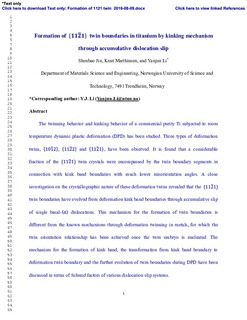| dc.contributor.author | Jin, Shenbao | |
| dc.contributor.author | Marthinsen, Knut | |
| dc.contributor.author | Li, Yanjun | |
| dc.date.accessioned | 2017-10-04T05:15:20Z | |
| dc.date.available | 2017-10-04T05:15:20Z | |
| dc.date.created | 2016-09-23T11:02:30Z | |
| dc.date.issued | 2016 | |
| dc.identifier.citation | Acta Materialia. 2016, 120 403-414. | nb_NO |
| dc.identifier.issn | 1359-6454 | |
| dc.identifier.uri | http://hdl.handle.net/11250/2458180 | |
| dc.description.abstract | The twinning behavior and kinking behavior of a commercial purity Ti subjected to room temperature dynamic plastic deformation (DPD) has been studied. Three types of deformation twins, {1012}, {1122} and {1121}, have been observed. It is found that a considerable fraction of the {1121} twin crystals were encompassed by the twin boundary segments in connection with kink band boundaries with much lower misorientation angles. A close investigation on the crystallographic nature of these deformation twins revealed that the {1121} twin boundaries have evolved from deformation kink band boundaries through accumulative slip of single basal-⟨a⟩ dislocations. This mechanism for the formation of twin boundaries is different from the known mechanisms through deformation twinning in metals, for which the twin orientation relationship has been achieved once the twin embryo is nucleated. The mechanism for the formation of kink band, the transformation from kink band boundary to deformation twin boundary and the further evolution of twin boundaries during DPD have been discussed in terms of Schmid factors of various dislocation slip systems. | nb_NO |
| dc.language.iso | eng | nb_NO |
| dc.publisher | Elsevier | nb_NO |
| dc.rights | Attribution-NonCommercial-NoDerivatives 4.0 Internasjonal | * |
| dc.rights.uri | http://creativecommons.org/licenses/by-nc-nd/4.0/deed.no | * |
| dc.title | Formation of {11-21} twin boundaries in titanium by kinking mechanism through accumulative dislocation slip | nb_NO |
| dc.type | Journal article | nb_NO |
| dc.type | Peer reviewed | nb_NO |
| dc.description.version | acceptedVersion | nb_NO |
| dc.source.pagenumber | 403-414 | nb_NO |
| dc.source.volume | 120 | nb_NO |
| dc.source.journal | Acta Materialia | nb_NO |
| dc.identifier.doi | 10.1016/j.actamat.2016.08.042 | |
| dc.identifier.cristin | 1384592 | |
| dc.relation.project | Norges forskningsråd: 222173 | nb_NO |
| dc.description.localcode | © 2016. This is the authors’ accepted and refereed manuscript to the article. LOCKED until 13.9.2018 due to copyright restrictions. This manuscript version is made available under the CC-BY-NC-ND 4.0 license http://creativecommons.org/licenses/by-nc-nd/4.0/ | nb_NO |
| cristin.unitcode | 194,66,35,0 | |
| cristin.unitname | Institutt for materialteknologi | |
| cristin.ispublished | true | |
| cristin.fulltext | postprint | |
| cristin.qualitycode | 2 | |

